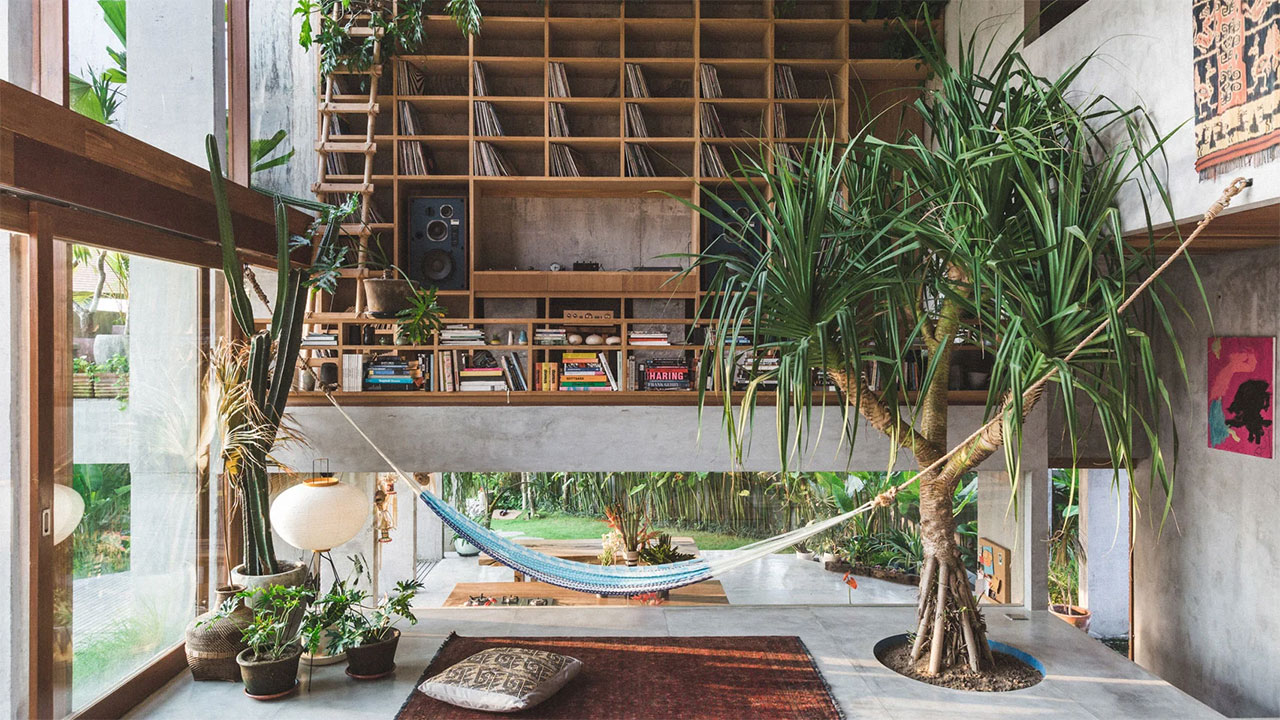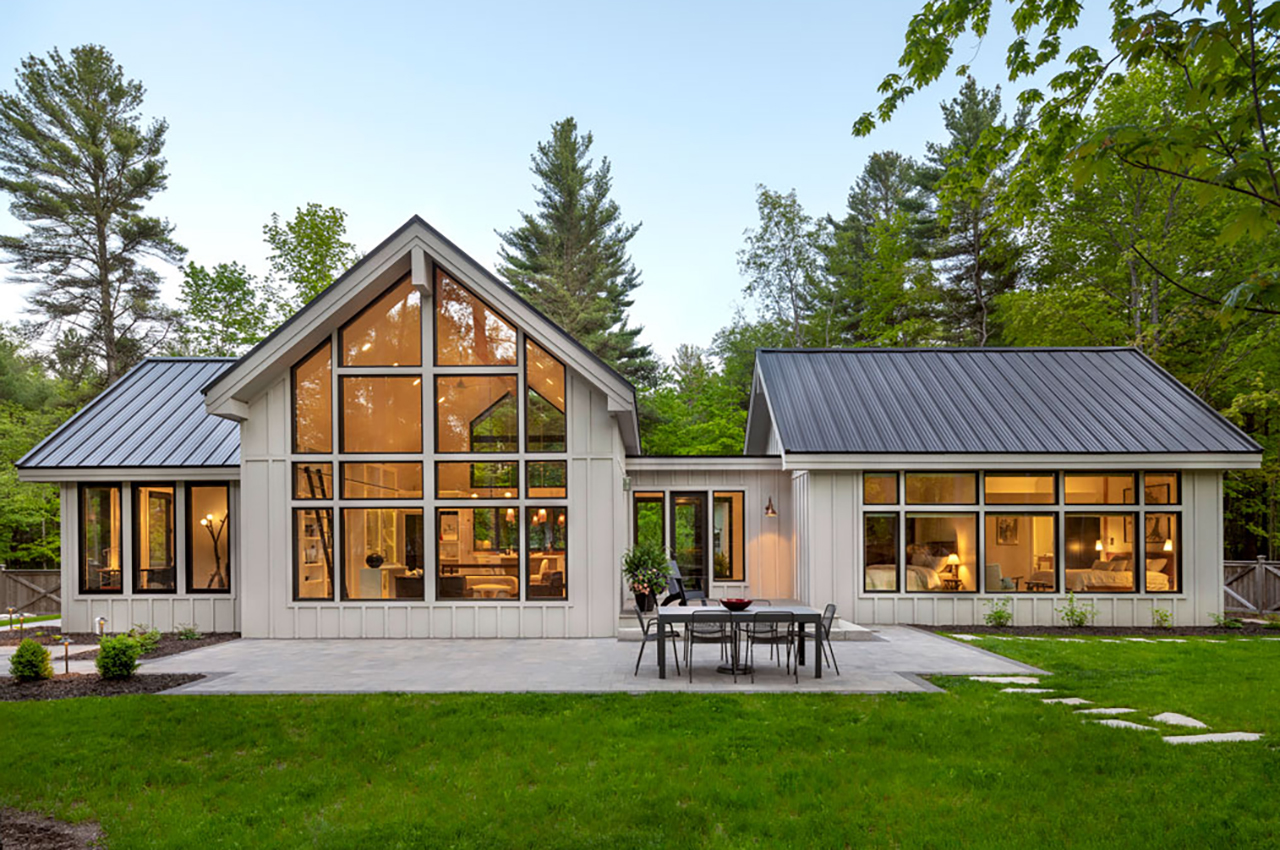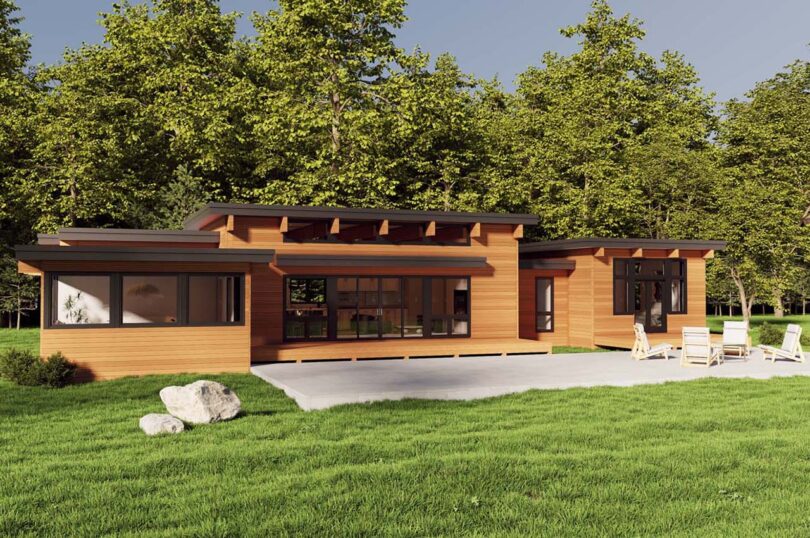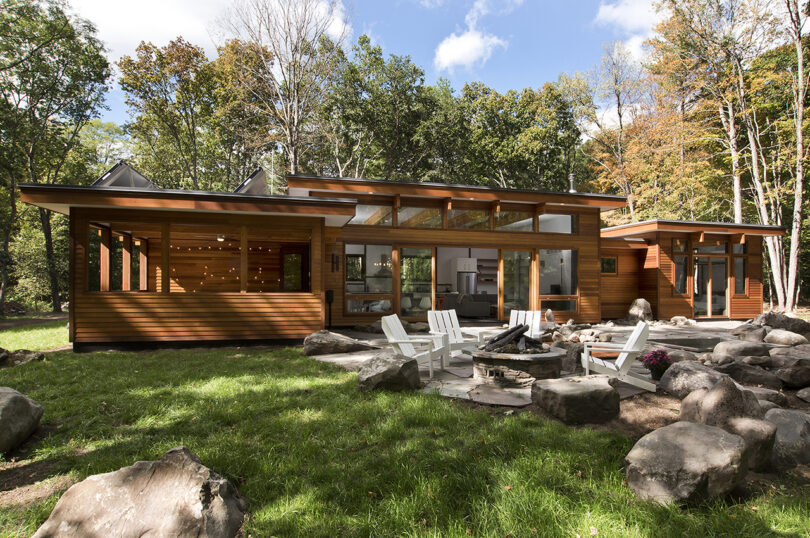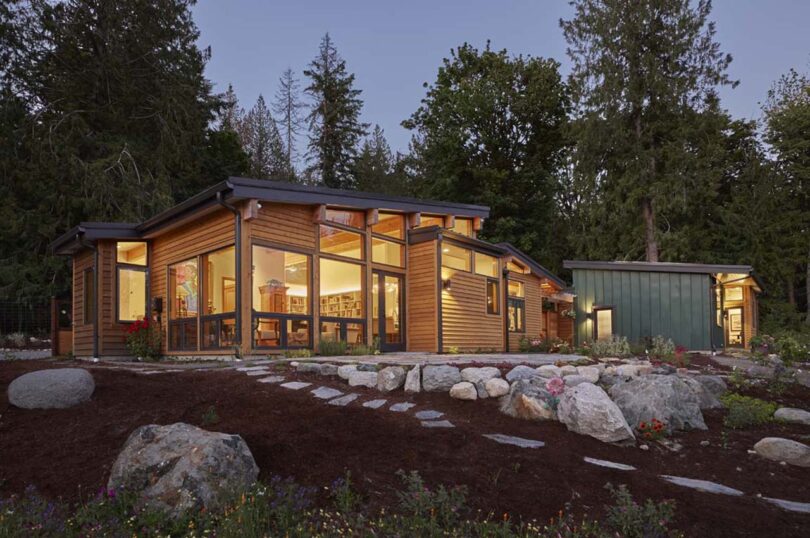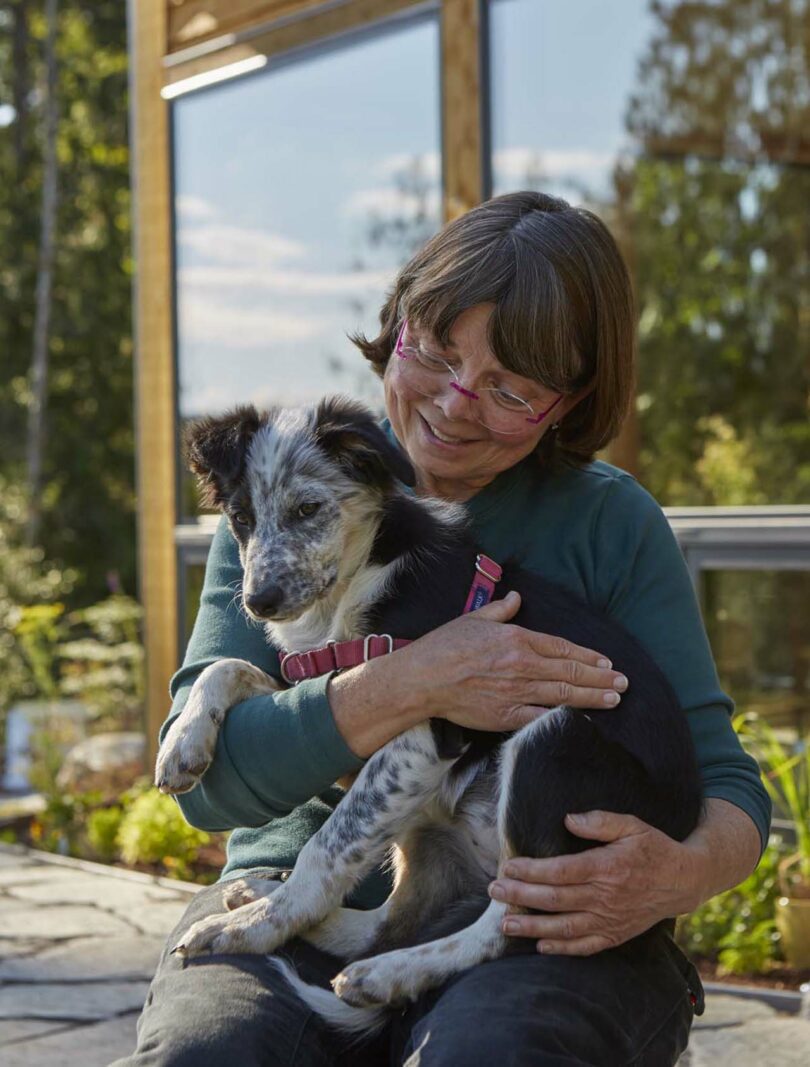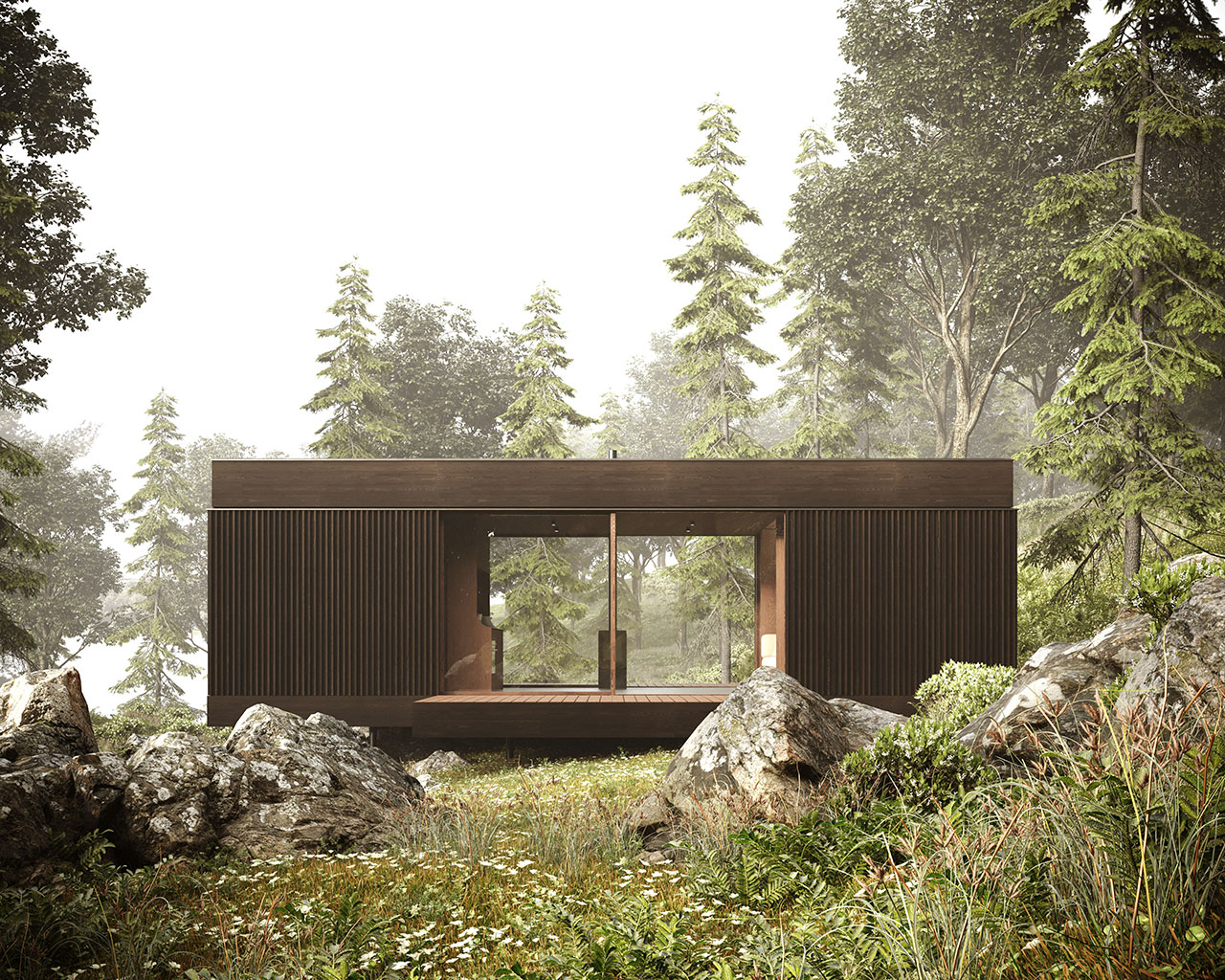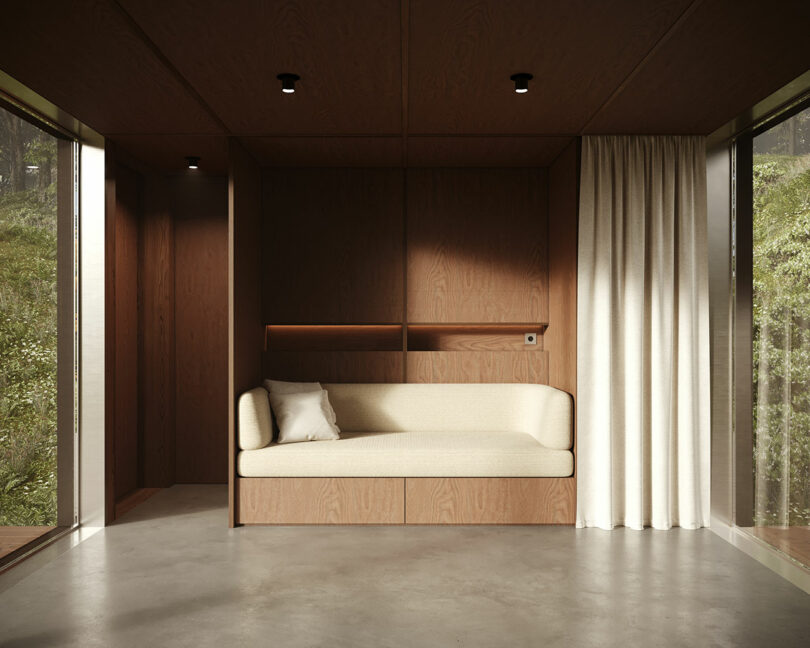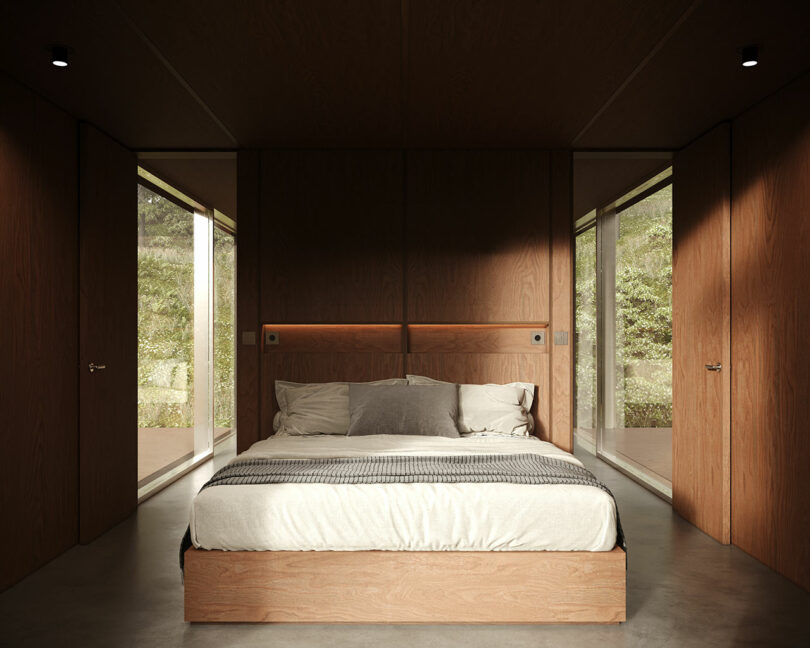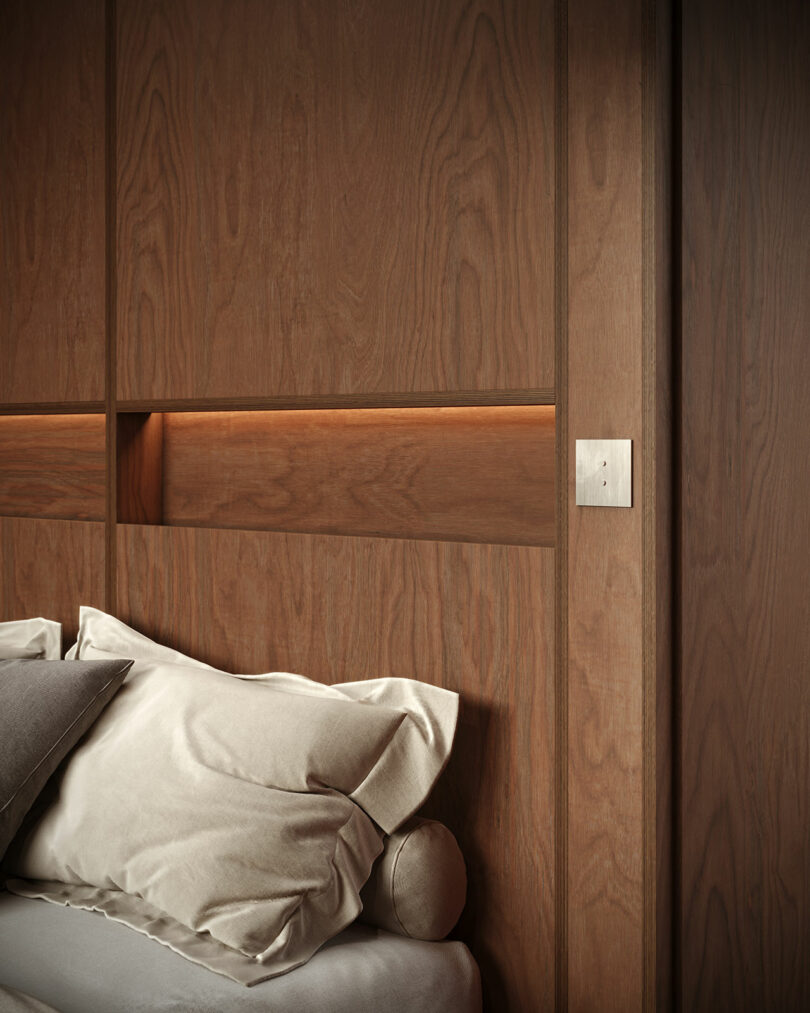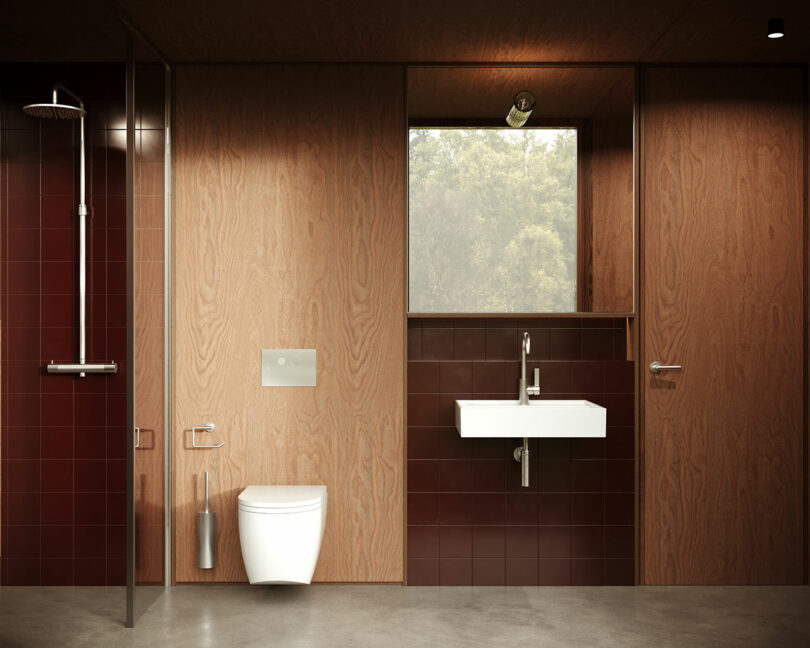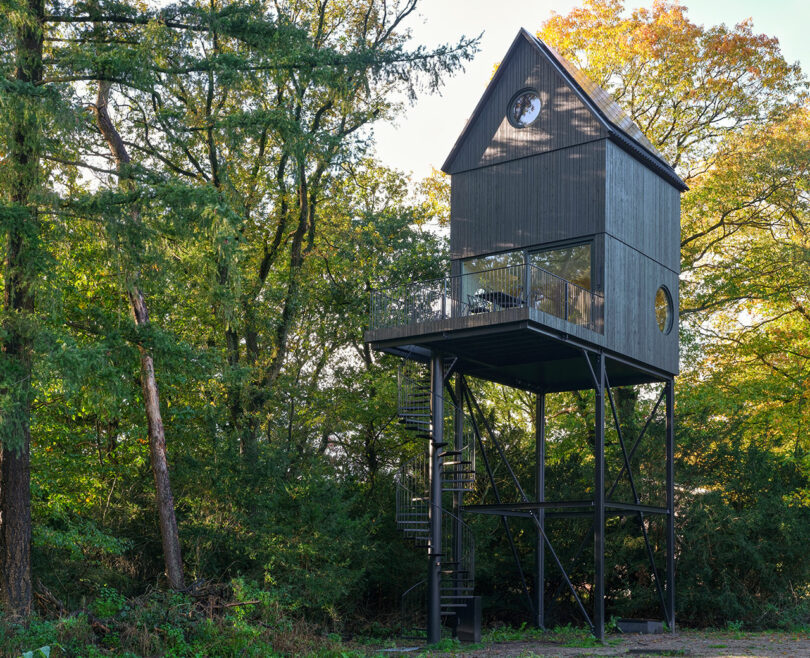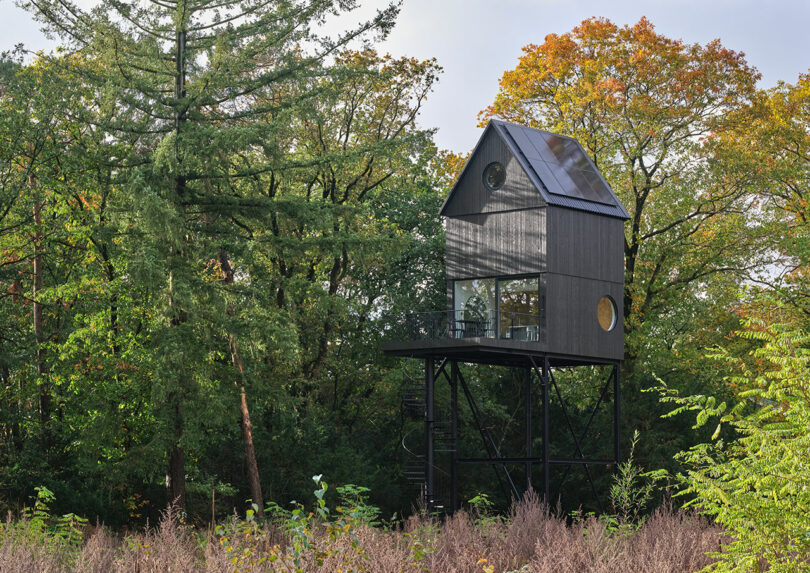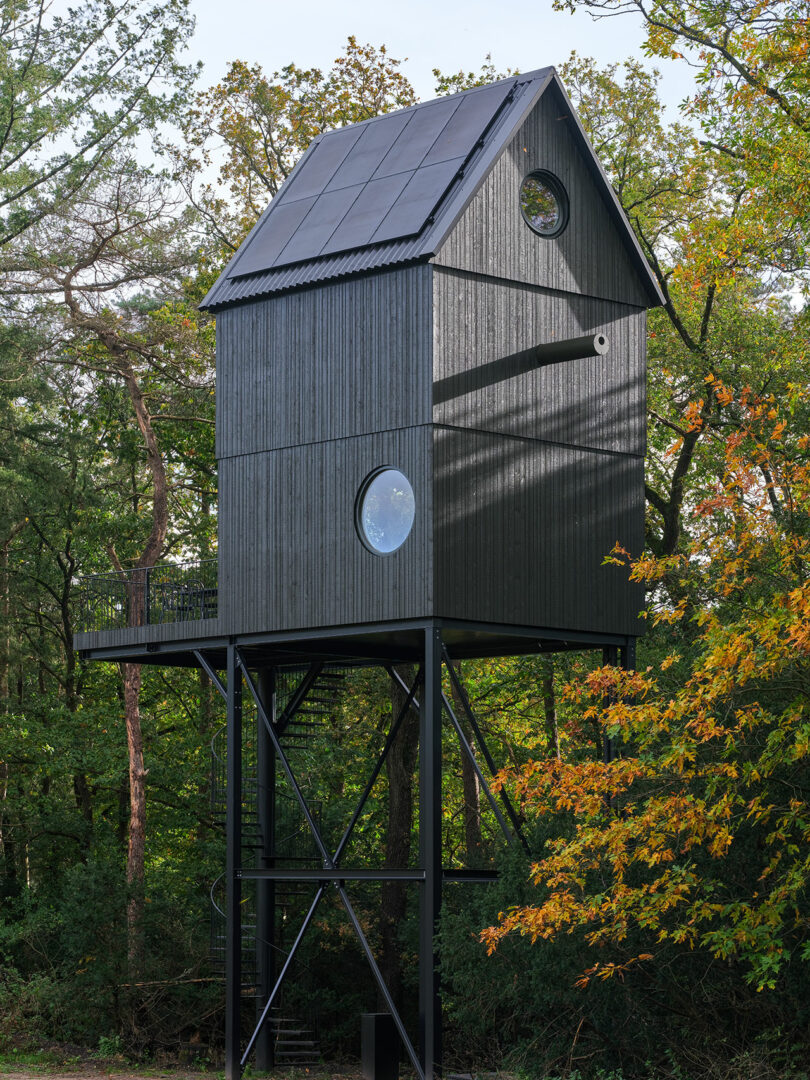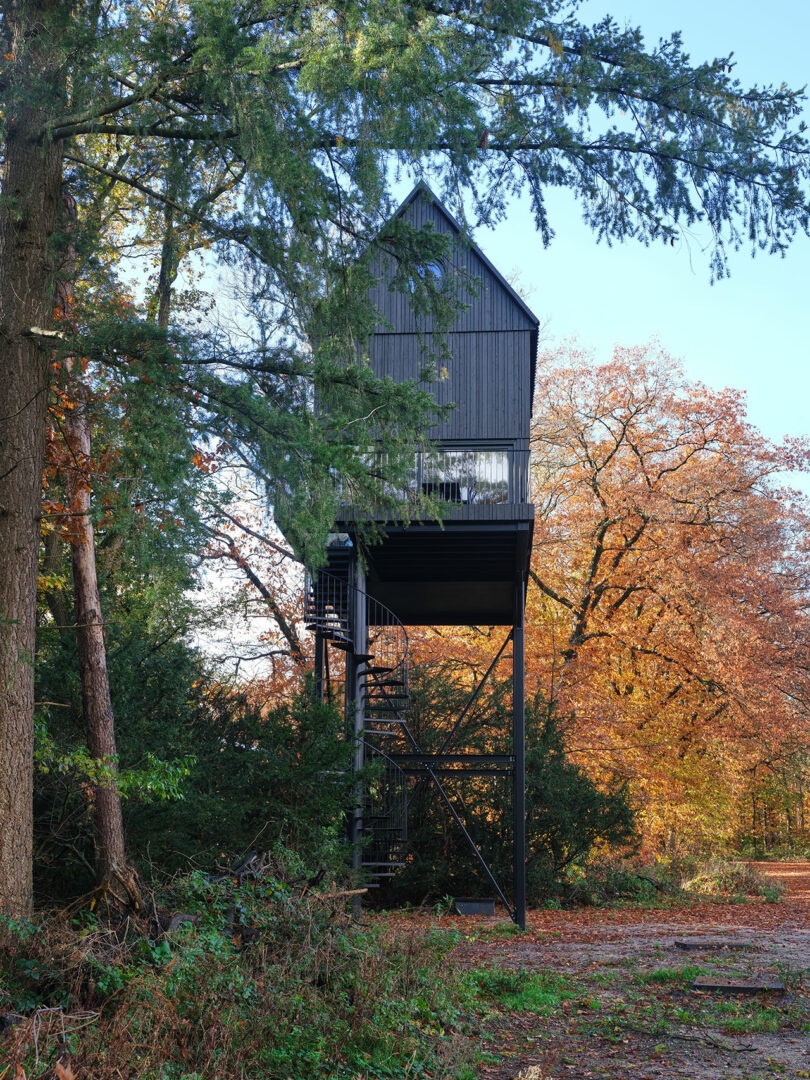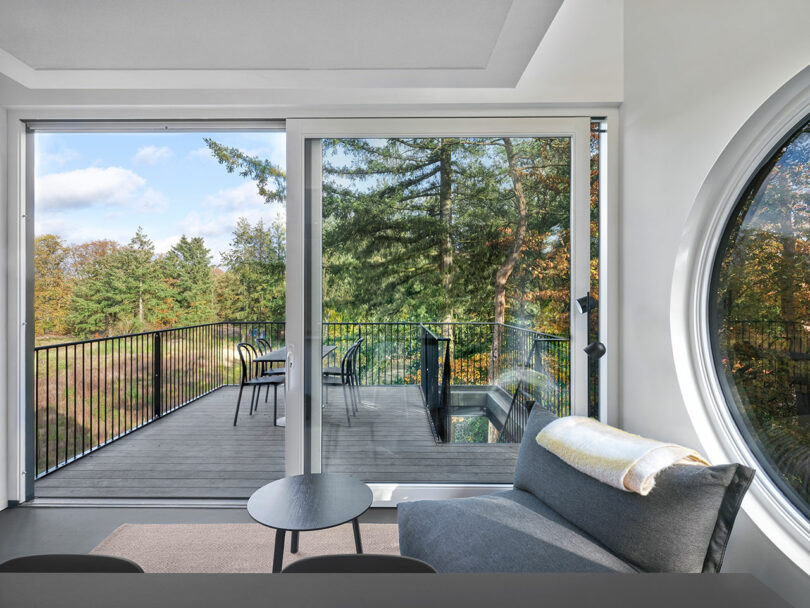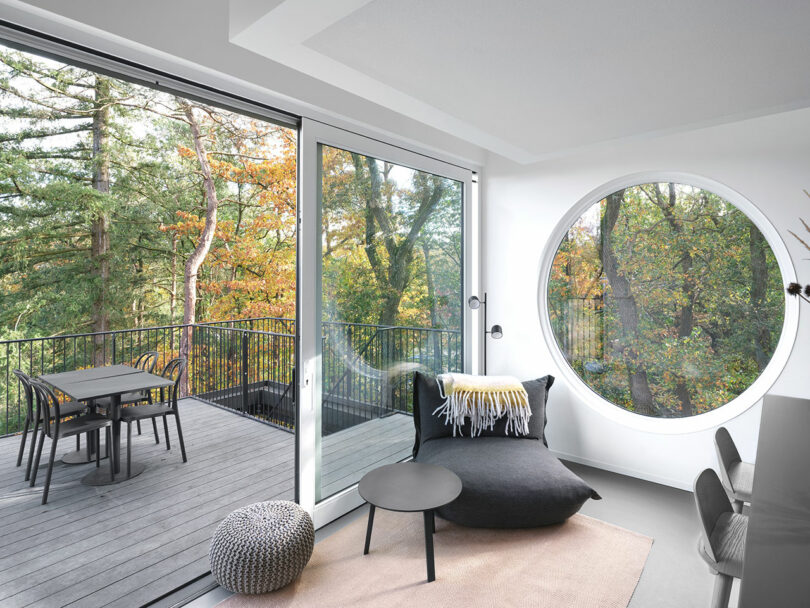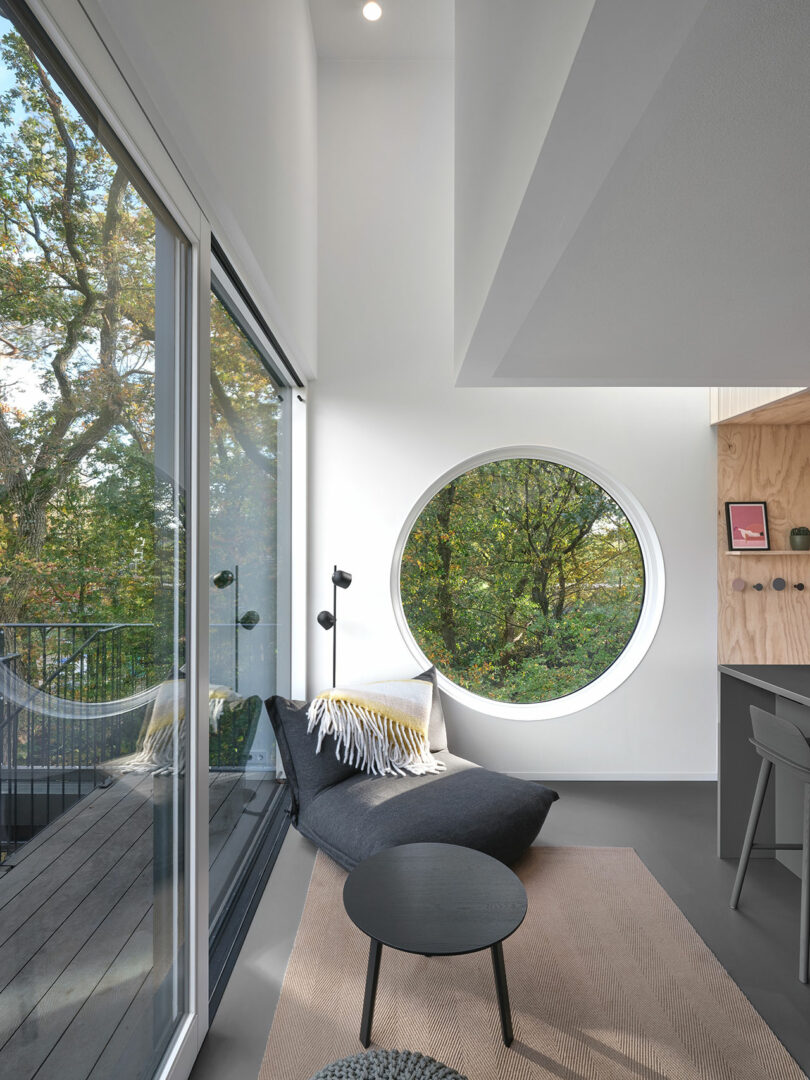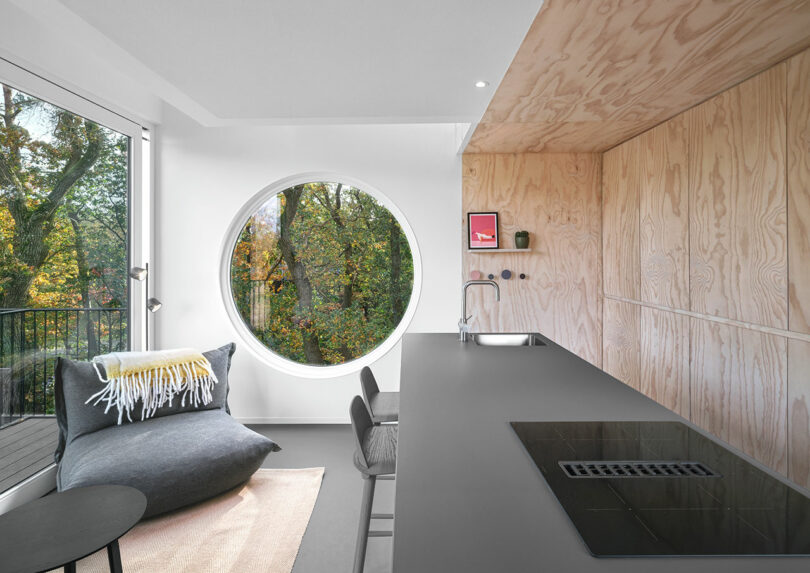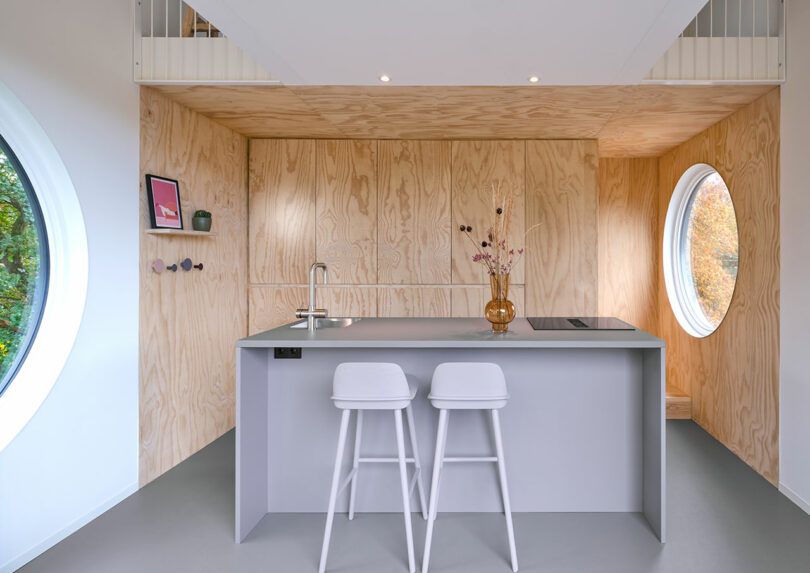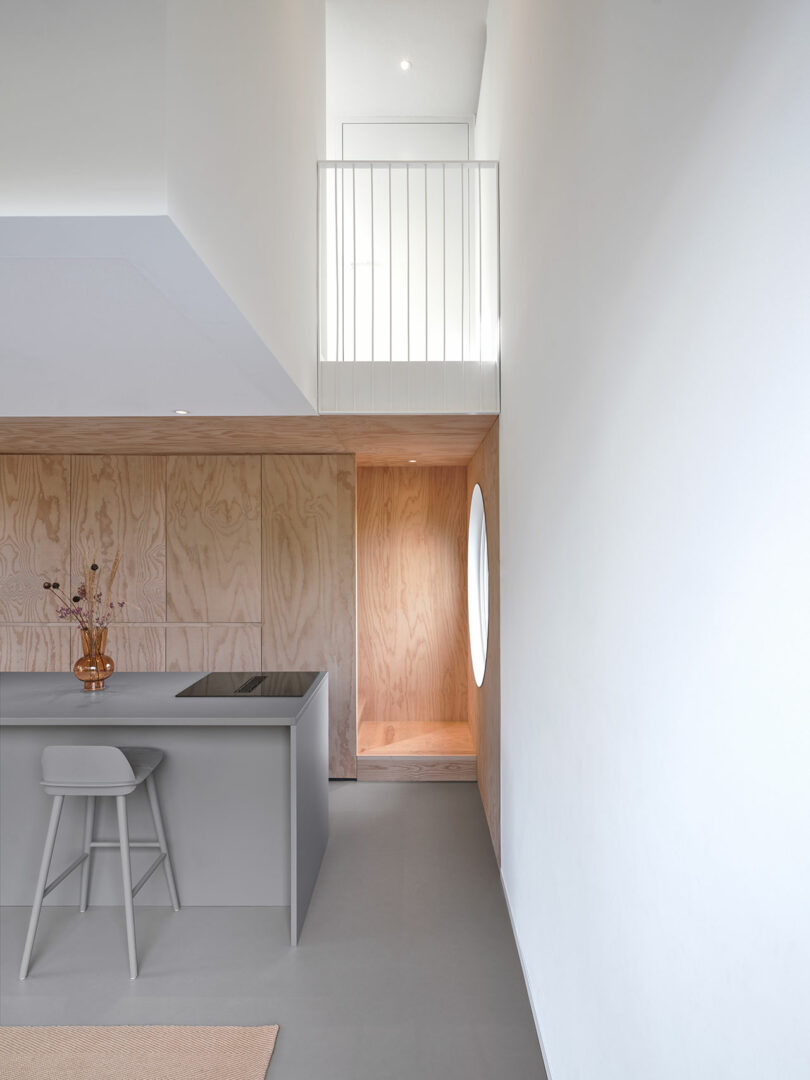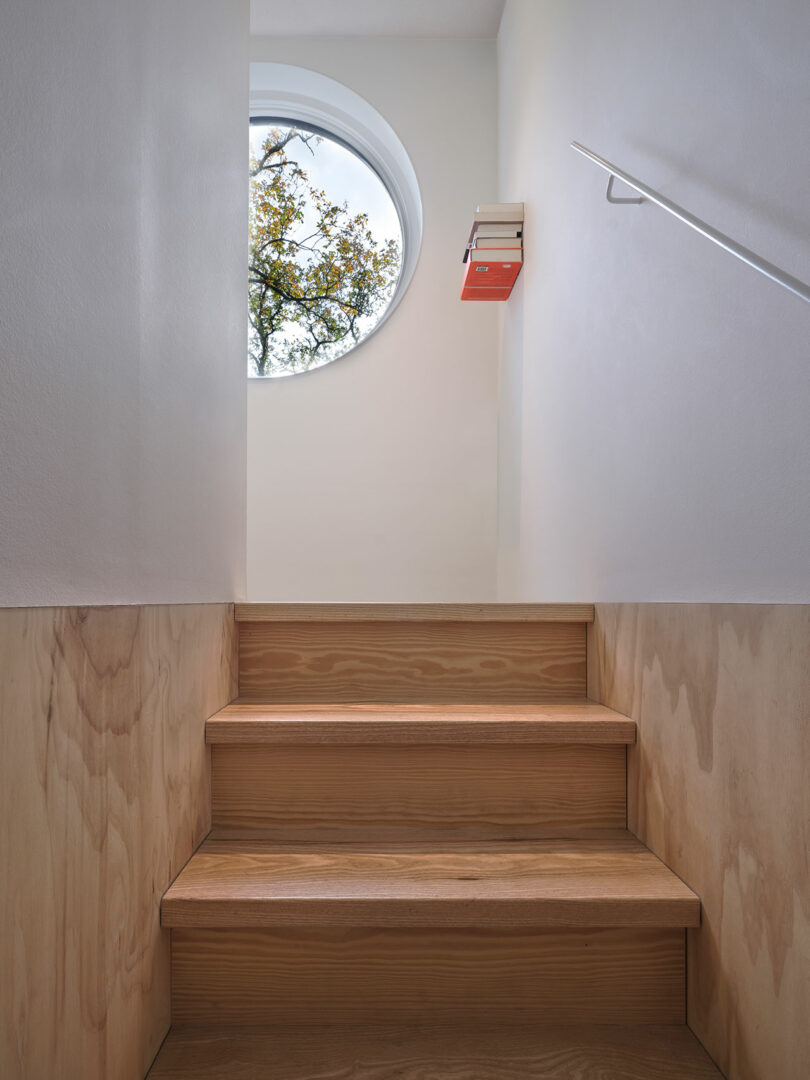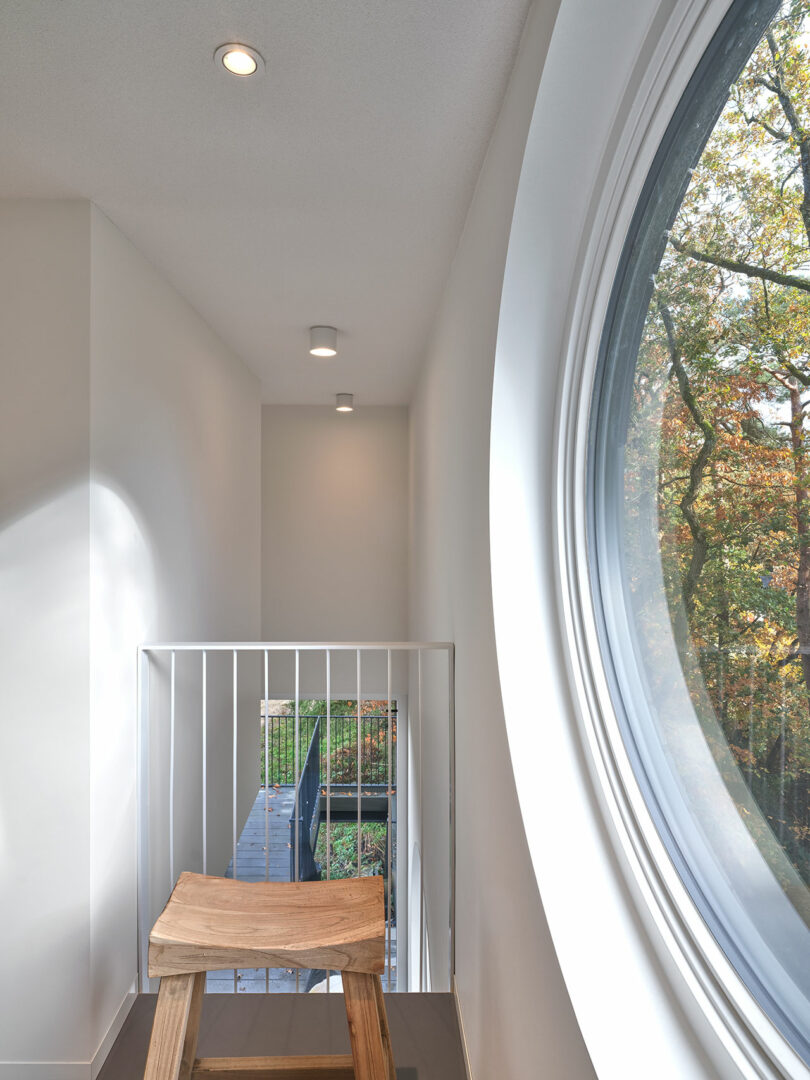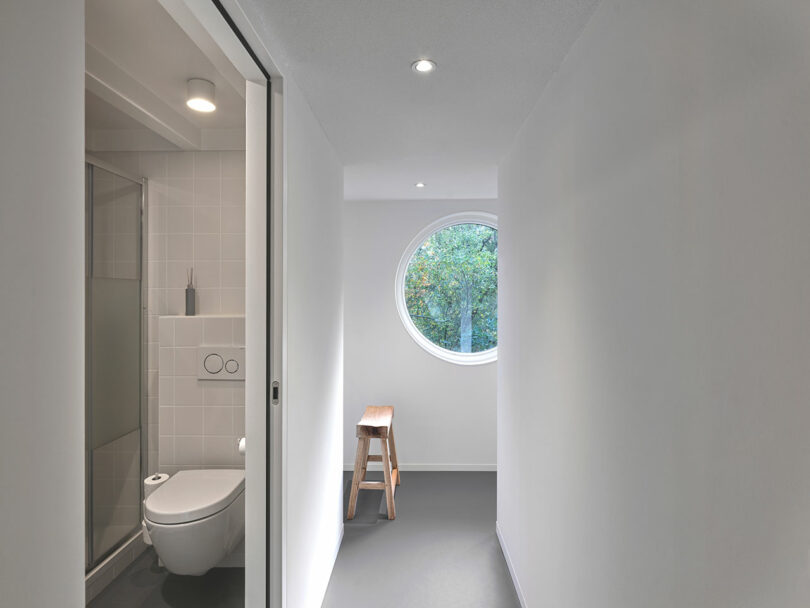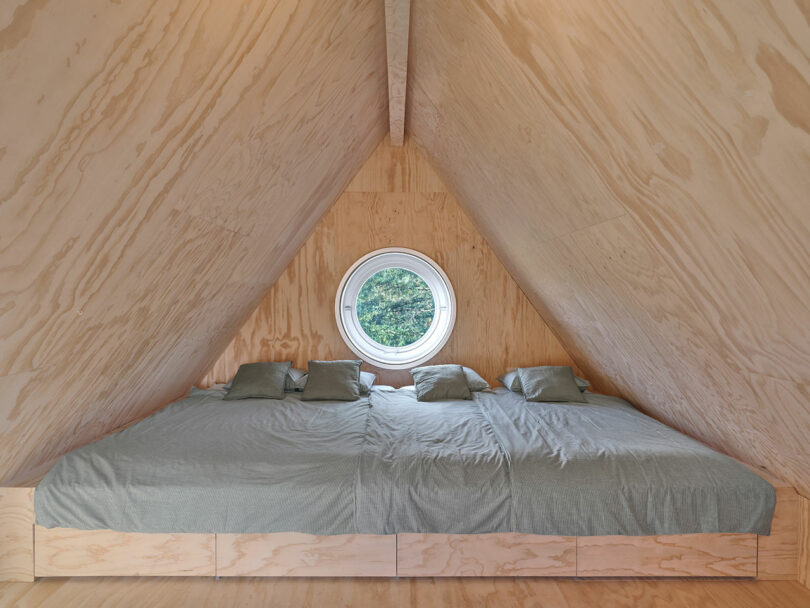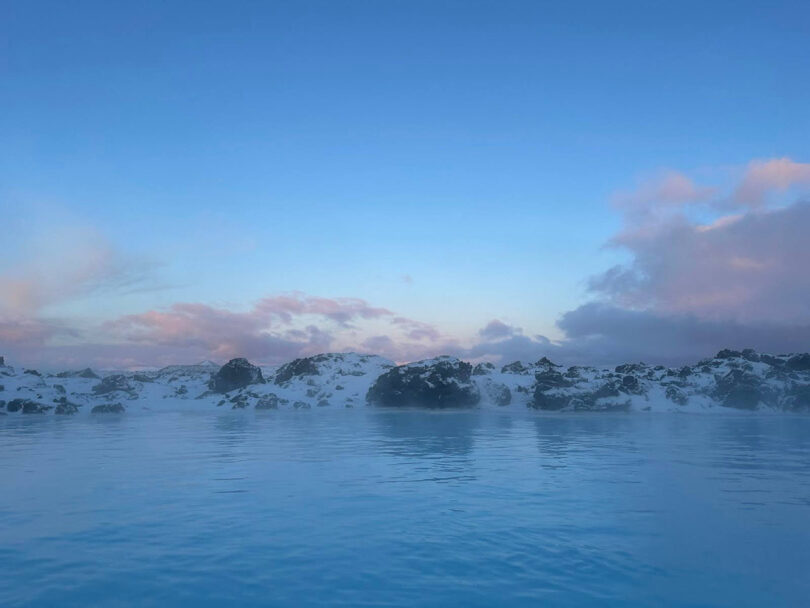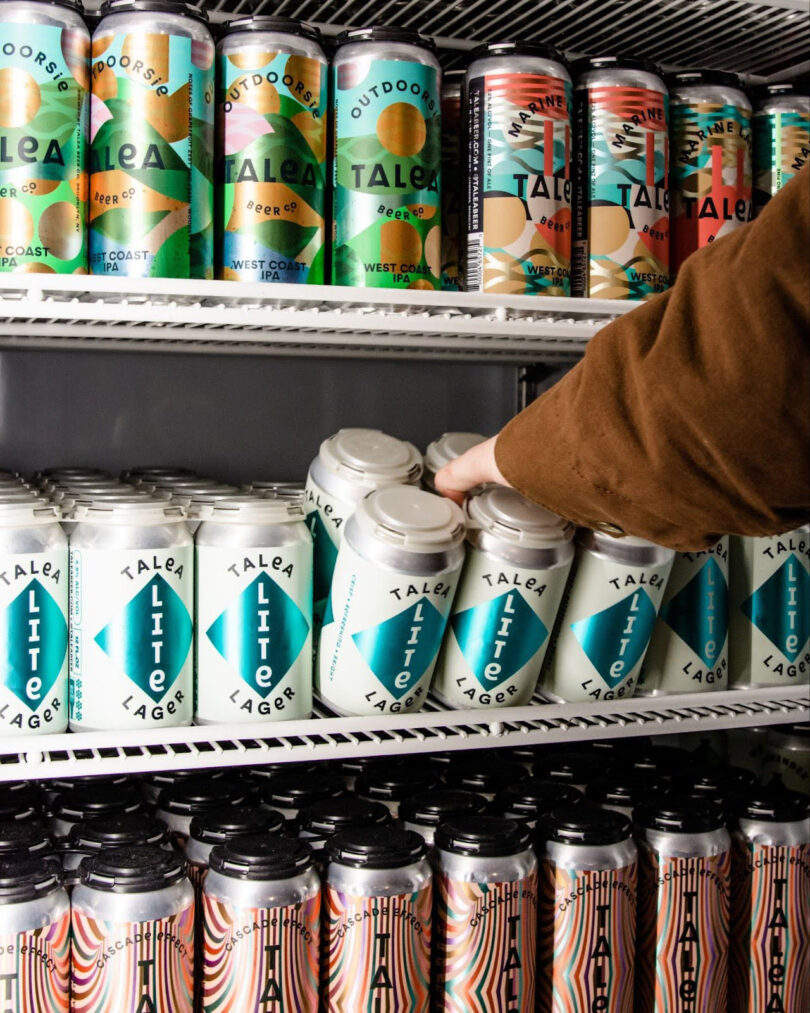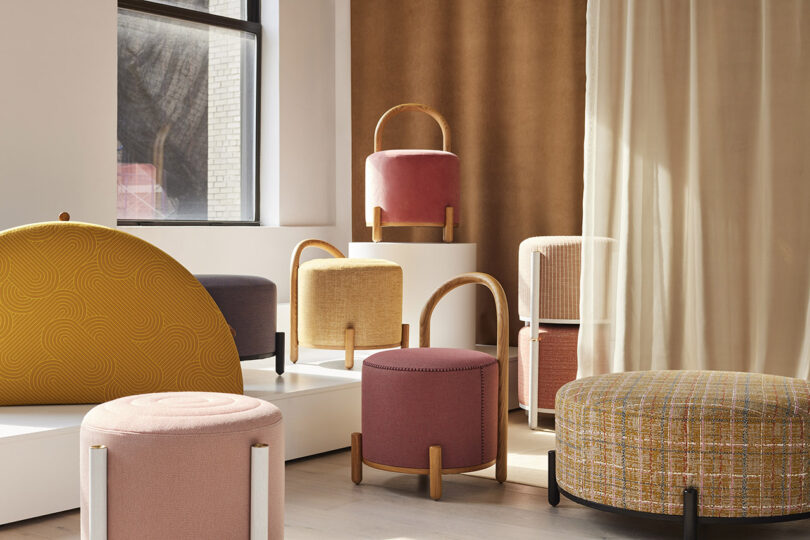Category: Architecture
10 Modern Homes With Living Trees Growing Inside
[ad_1]
Located in Bali within fields of rice, the Brutalist Tropical Home is designed by Patisandhika Sidarta (now of architecture firm Sidarta and Sandjaja) and designer Daniel Mitchell with large open air spaces and a multi-level layout. In the living room, there’s a hammock for relaxing alongside a tree planted right into the concrete floor.
Photo: Norihito Yamauchi
In Osaka Prefecture in the city of Yao, Japan, the Melt House is a narrow residence where the homeowners asked SAI Architectural Design Office to bring nature inside. To make it happen, they designed a double-height courtyard that’s enclosed allowing for use all year round. In front of a large window, a tree is planted in a gravel pit making it feel as if it was outside.
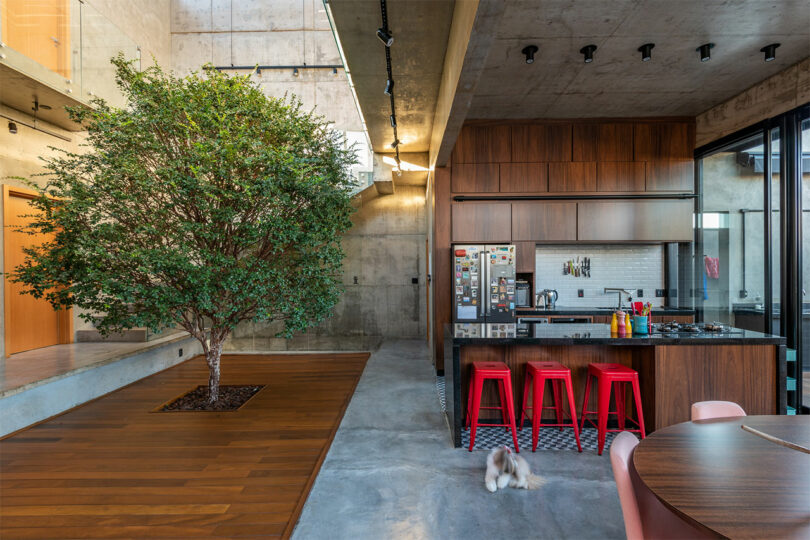
Photo: Favaro Jr.
The Box House in Araraquara, Brazil, designed by Caio Persighini Arquitetura, leans in on the contrast of the two main materials used throughout – concrete and cumaru wood. Wooden components are thoughtfully incorporated to warm up the concrete walls and floors, with the added bonus of the home’s focal point being a live Jabuticaba tree planted dead center in a section of wood embedded in the concrete floor.
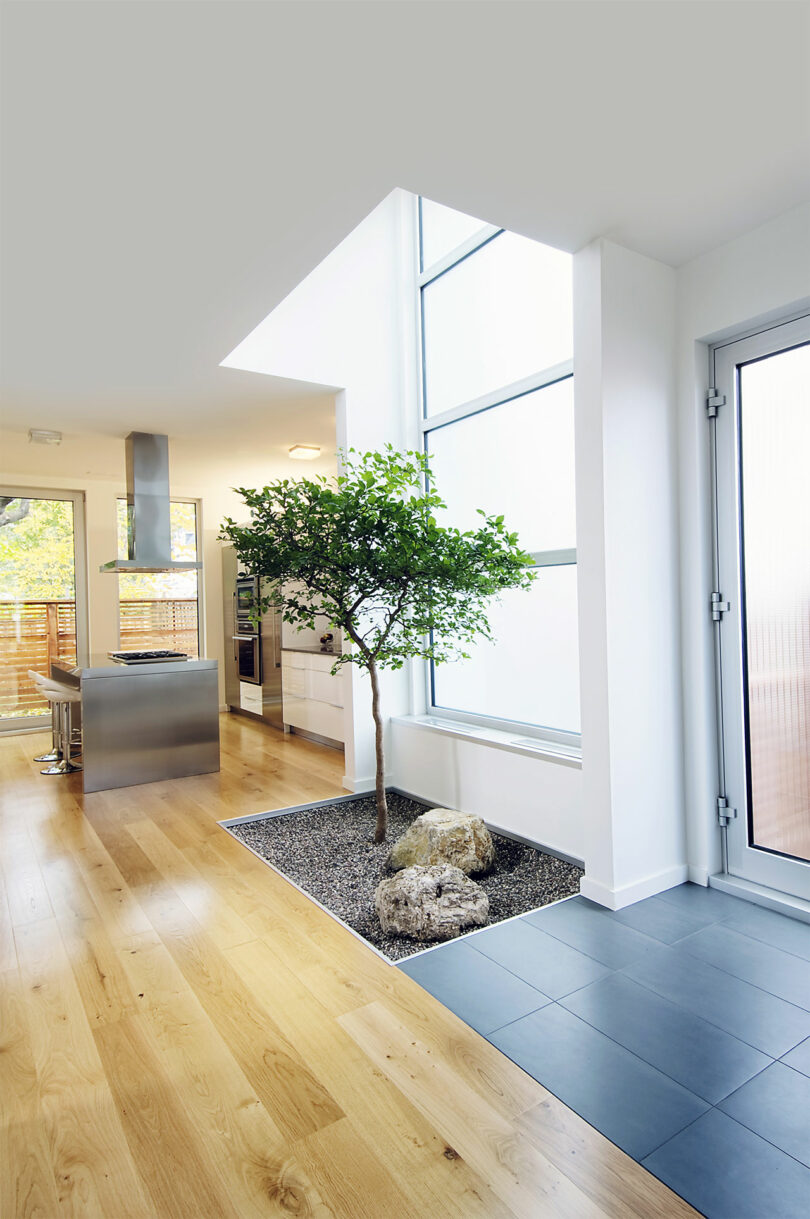
Photo: Erin Borg and Doublespace Photography
With Ottawa’s long winters, LineBox Studio brought the outdoors in with a tree garden placed right next to the front door of the Fold Place, welcoming the family and guests as the enter the space. Not only can the growing tree be seen as people come and go, it’s located so anyone in the kitchen has views of it while they cook.
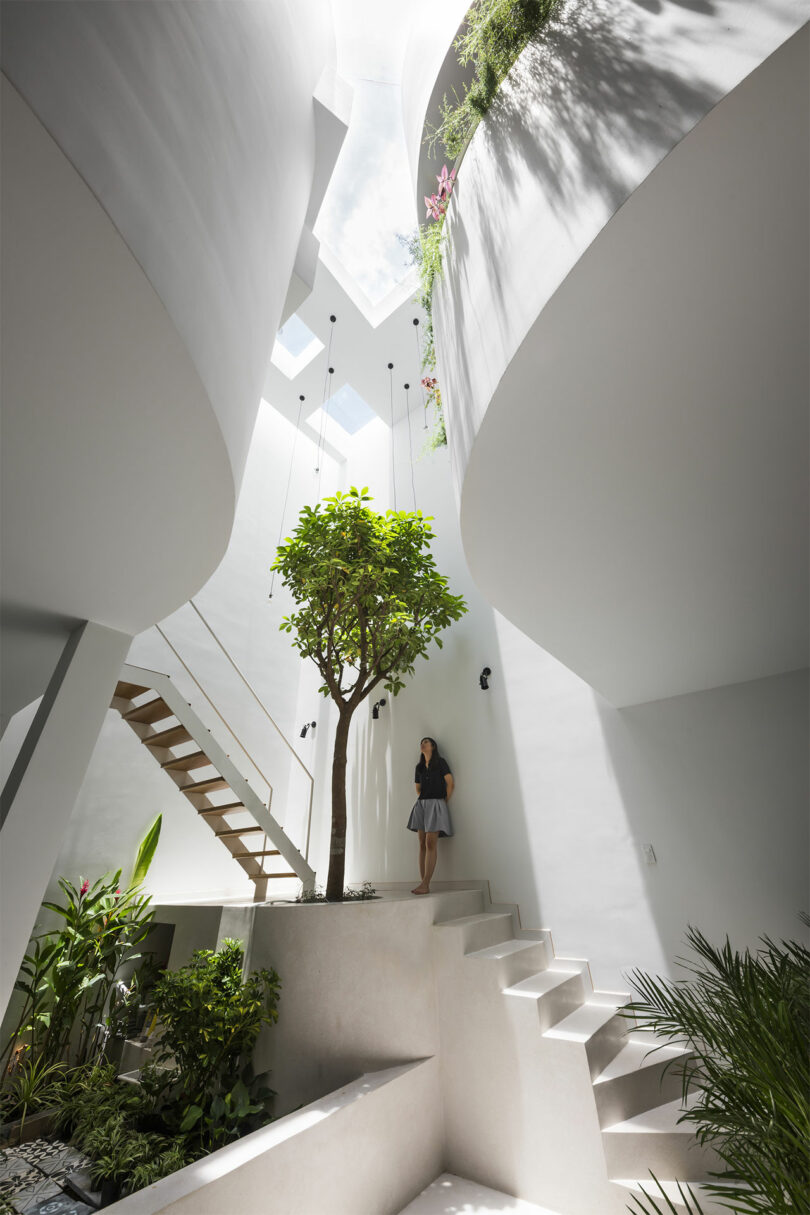
Photo: Hiroyuki Oki
Designed for a young woman and her visiting family in Ho Chi Minh City, Vietnam, the appropriately named House for a Daughter is an open and airy residence from Khuon Studio. The goal was to prioritize natural light and plants, which they did just that with multiple built-in gardens for varieties of plants, as well as a tree embedded into a stairwell landing in a white-walled void within the home.

Photo: Yosuke Ohtake
The family House in Kyoto, Japan, designed by 07BEACH, features an open living plan that allows the active children to be watched by their parents no matter where they are. With surrounding houses built right up close to each other, the property left no room for an actual garden requiring the designers to think outside the box. Their solution? They designed a double-height main room with skylights above filtering natural light down to the central indoor tree, making the space feel connected to the outdoors.

Photo: Delfino Sisto Legnani and Alessandro Saletta from DSL Studio
Built around a 10-meter-tall ficus tree, the Greenary is a residence modeling a traditional Italian farmhouse reimagined with a modern approach by Carlo Ratti Associati. The 60-year-old tree lives in the middle of the house in front of a massive glass wall allowing sunlight to pour in. The house is outfitted with technology to ensure the tree and the owners can live in harmony with the optimum temperature and humidity for both.
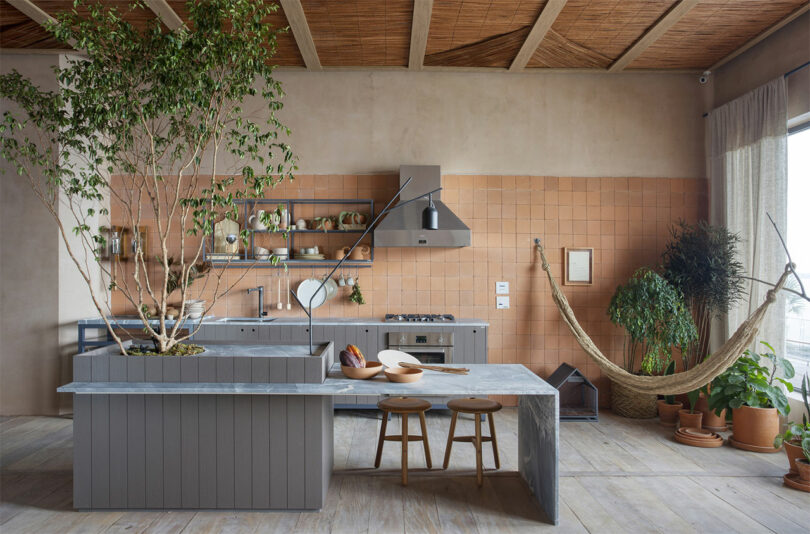
Photo: Denilson Machado of MCA Estúdio
For 2019’s interior design and architecture fair Casa Cor Rio, Natália Lemos and Paula Pupo designed Estúdio Elã, a modern apartment in Brazil inspired by singer Ney Matogrosso. Terra cotta tiles on the back wall are juxtaposed with warm gray cabinets that continue to the central island that’s outfitted with a jabuticabeira tree planted at one end.
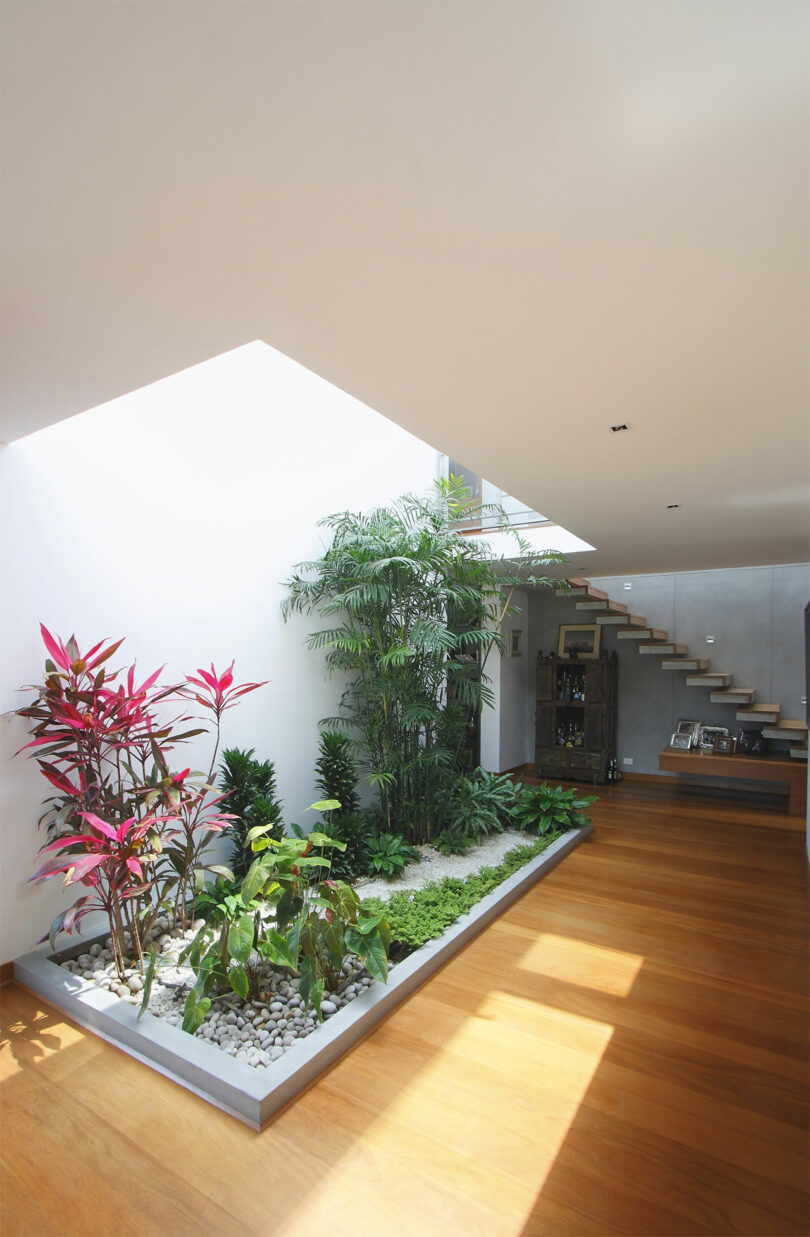
Photo: Juan Solano Ojasi
Located in Lima, Peru, Casa Cachalotes is a family home, designed by Oscar Gonzalez Moix, that takes inspiration from the lush surroundings by bringing nature to the indoors. A double-height living space with skylights hovering above, is home to an indoor garden that includes plants and a tree that are showered with natural light throughout the day.

Photo: Yohei Sasakura
In House with a Margin, yukawa design lab created their own residence in Ibaraki, Japan, that focuses on light, wind, greenery, colors, and activities. An inner atrium with a double-height space and a wall of windows, houses a central tree that grows up through to the second floor so nature can be seen from all interior spaces.
[ad_2]
Source link
Build Your Modern Dream Home With Lindal’s Quick Ship Program
[ad_1]
Lindal Cedar Homes is beloved by architects and lovers of architecture alike – we’re big-time fans of the Alpha A-frame! It turns out that so many of us appreciate the brand’s thoughtful kit designs and easy installation that they’ve introduced a Quick Ship program – a fast and efficient way to turn your modern dream home into a reality. The Quick Ship program offers a selection of Lindal’s best-selling homes that have been pre-drafted, allowing for a fast turnaround time and delivery to your build site, whether it be in the mountains, at the beach, or somewhere in between.
While it might sound a bit like a 1950s cookie cutter house at first, rest assured that Quick Ship includes a menu of optional modifications that can make your new home’s style feel perfectly personalized, all in an efficient and cost-effective way. Sound too good to be true? It gets even better because Lindal’s Quick Ship homes are sold at a discount.
With so many architectural options to choose from, we’re sharing three of their most popular designs. First up is Ash, seen above, a modern home featuring a classic profile with design details you might find in a farmhouse style, like the way its structures are connected and a sloped metal roof. Walls of glass on the frontside, a single-story layout, and a flat-roofed entry divide the public and private areas of the home. Choose from four layout options within the Ash family and create your perfect space, be it a getaway or primary home.
With three bedrooms and two baths, the one-floor BAYSIDE 1621 design offers its owner open living in the biggest sense of the term. The dramatic front of the structure is made of glass and shaped like a ship’s bow, while the great room, dining room, and kitchen share the interior space and stunning views that come with it. Though modest in size, this home feels larger thanks to high ceilings and a light-filled interior. There’s even a dedicated private primary bedroom suite as the icing on the cake. Expanded versions of the original Bayside design are also available if you’re looking for something with a larger footprint.
What’s the epitome of mid-century living? A ranch-style home of course, just like Sargasso. Comfortable and welcoming upon first sight, the one-level floor plan features a large wall of windows that allow nature to come right in. Sargasso’s large gathering area is perfectly designed for the host or hostess, with plenty of space for entertaining until the sun comes up. If you happen to own a sloped lot, you can opt to add a lower level, increasing your square footage exponentially.
For a limited time, get 15% off your Quick Ship home package and save 50% on design fees. Contact your local Lindal representative for details and personal support throughout the process of buying and building. Register here to access the brand’s free Quick Ship house plan e-book, featuring all the floor plans and variations currently available.
As a bonus, if you’re interested in Net Zero Smart Homes, you have the chance to learn from Lindal homeowner and retired tech entrepreneur Laurie Pitman on Tuesday, March 26th, at 5 p.m. PT/8 p.m. ET. Listen in on the “Building a Net Zero Smart Home with Lindal” webinar as Pitman discusses her fully Net Zero Smart home and how you too can incorporate eco-friendly features and automated internet-connected devices into your own Lindal home. Register here!
[ad_2]
Source link
The Judy Earns Design Excellence Award from Boston Architecture Group – Marymount Manhattan College News
[ad_1]
The Judy Earns Design Excellence Award from Boston Architecture Group Marymount Manhattan College News
[ad_2]
Source link
Landet Offers a New Paradigm for Hospitality Near Stockholm
[ad_1]
The patinated, earthen hues of Simon Ungers’ expansive T-House. The plinth from Ludwig Mies van der Rohe’s Farnsworth House. And generous glazing like that in Philip Johnson’s Glass House. Elements from these iconic homes are echoed in Landet, a series of modern cabins designed by Swedish architect Andreas Martin-Löf for the emerging hotel brand. The brainchild of co-founders Umberto Garabello and Ted Wachtmeister, Landet marks a new hospitality concept where preserving the natural environment is as much a focus as creature comforts and contemporary design. It offers thoughtfully planned, sustainable cabins located in a reserve near Trosa, one of the nation’s most picturesque archipelagos an hour outside of Stockholm, to provide an eco-friendly escape from the din of city living while still accessible by public transport. Aptly named – its moniker is Swedish for “the country” – the architecture is idyllic, empathetic, and highly edited.
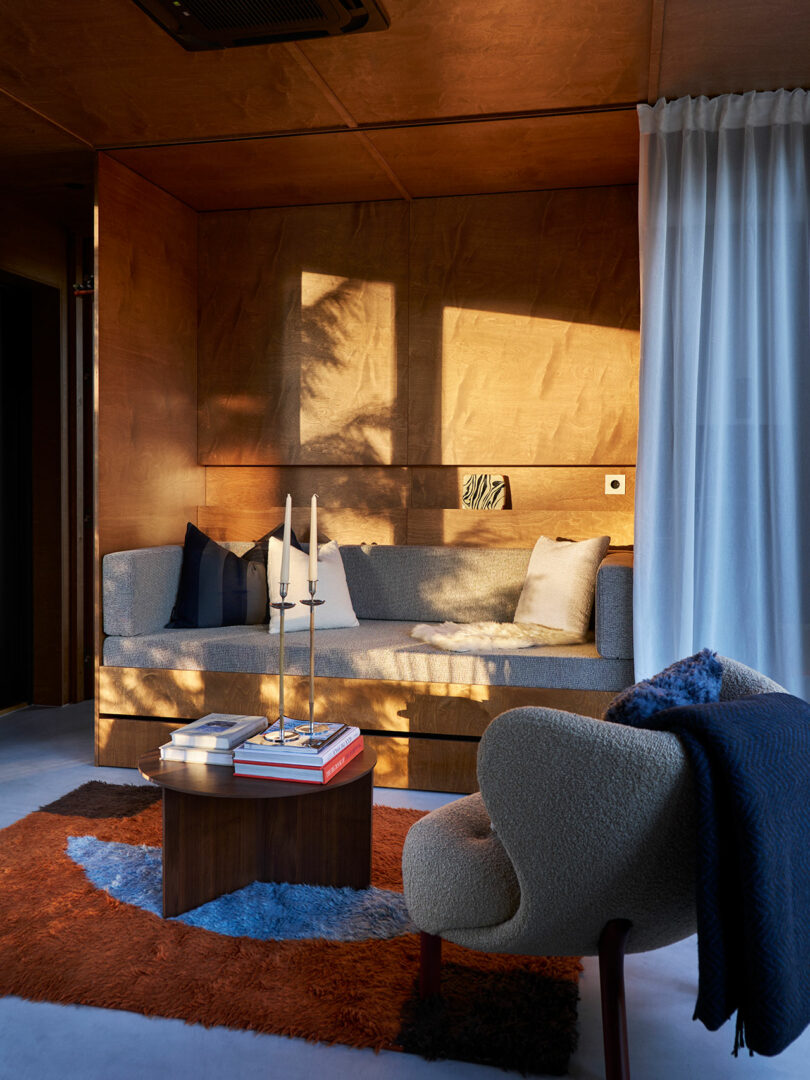
Photo: Magnus Mårdig
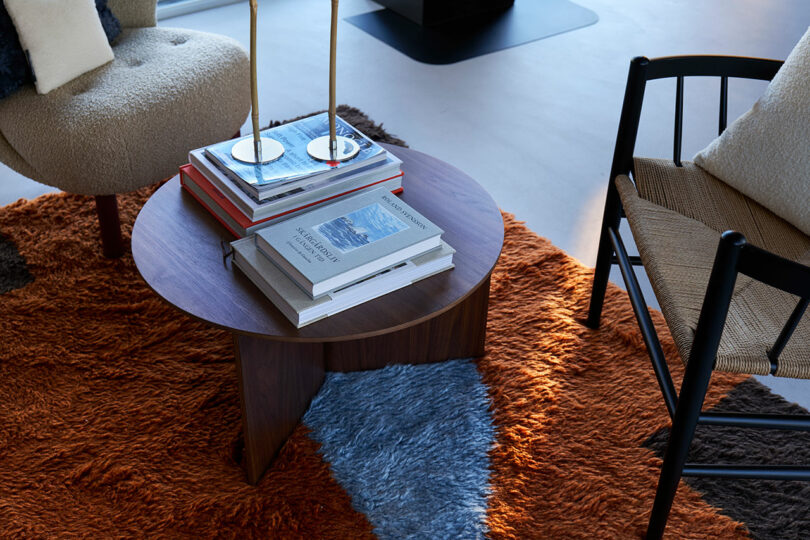
Photo: Magnus Mårdig
Dotting the 400-hectare landscape are four roughly 430-square-foot cabins situated in context with extreme precision intended to preserve the pristine flora and fauna. By working with fully fitted and furnished volumetric buildouts, Martin-Löf and the Husverket construction team avoid invasive and otherwise disruptive construction on site. Instead, each unit is manufactured in a local factory off-site, brought in, and placed on a simple plinth foundation, which creates the illusion of floating above the rock and lends itself to easy dismantling. As guests of the forest, the architect ensures that no permanent destructive human intervention is made. “I learned that it is possible to refine this type of building to a much higher level than we have done in previous projects and that we could protect the surroundings better by working elsewhere,” Martin-Löf says.
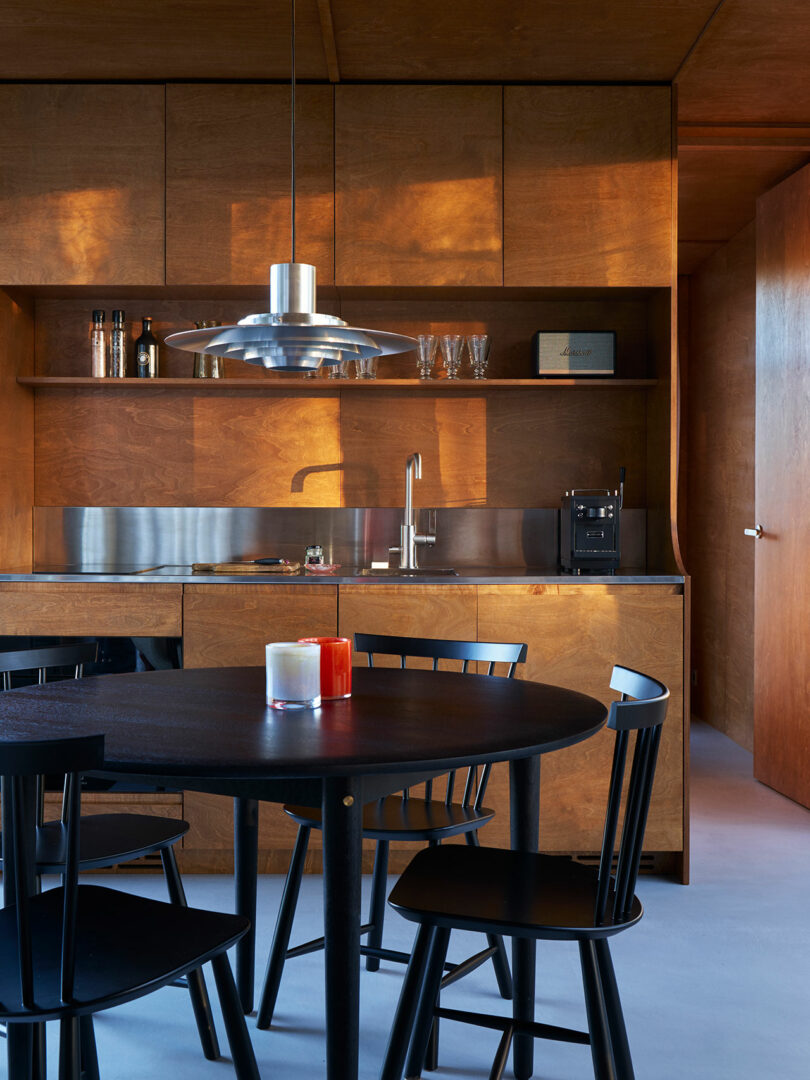
Photo: Magnus Mårdig
Sparsely detailed, the exterior of each wood-clad cabin is coated in all-natural, black-brown pine tar, traditionally used in Scandinavia to preserve the material’s longevity when exposed to harsh conditions. Protruding decks, millwork, and mantles move the eyes in, up, and over in celebration of the expanse within which the structure is visually locked. That same level of refinement and simplicity permeates the interior with a well solved and efficient plan atop microcement floors, which hosts 2-to-4 guests with every visit. Each building is fully equipped with modern accoutrements that facilitate extended stays – not to mention services like massages, yoga classes, meditation sessions, and grocery delivery. Bookended between floor-to-ceiling glass, the programming includes a living room with a fireplace, dining area, and a well-equipped kitchen. The bedroom includes lush textiles, and the ensuite bathroom has heated floors and a rain shower.
Finding synergy in a shared ethos, the London-based designer Tobias Vernon was enlisted by Landet’s co-founders to lend an international sensibility to the project while collaborating with Martin-Löf to maintain a distinctly Swedish identity. “Andreas brought a wonderful materiality to the project in terms of natural timbers and contrasting metal surfaces. There is a classicality to these whilst also being contemporary and bold. We ensured the interiors remained restrained but juxtaposed this with elements of color and visual contrast.” Vernon says. “We also worked closely with the Danish furniture brand &Tradition to develop a version of their iconic Little Petra armchair, exclusive to Landet, with red lacquered legs – it’s adorable!” Additional furnishings and finishes are sourced from local artisans to eliminate the cost of shipping and subsequent carbon footprint.
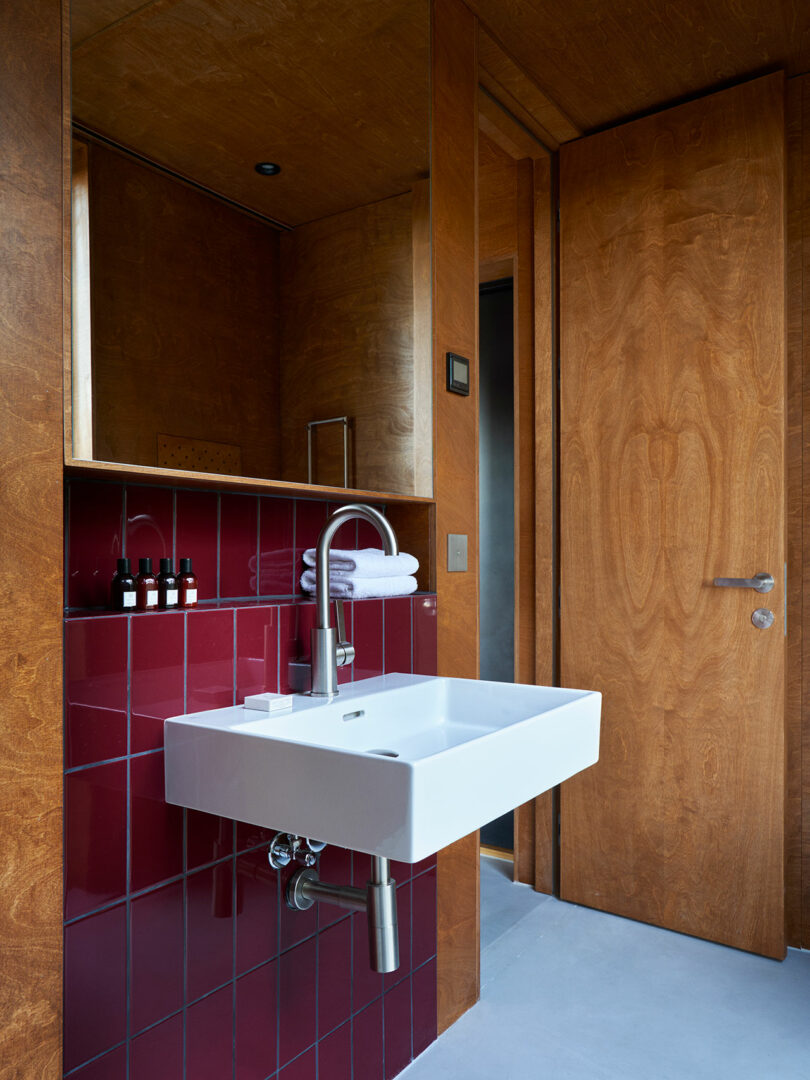
Photo: Magnus Mårdig
Landet’s allure draws guests that are said to include pop and political royalty alike. “Andreas’ practice manages to strike a perfect balance between architecture that is noteworthy yet discreet,” Garabello says. “The cabins are designed to blend into the environment while making a strong architectural statement.” With another six cabins in the works locally, the company hopes to bring this uniquely Scandinavian way of life to the countryside elsewhere throughout Europe. Cozy, comfortable, and extremely considerate, a new paradigm for hospitality emerges.
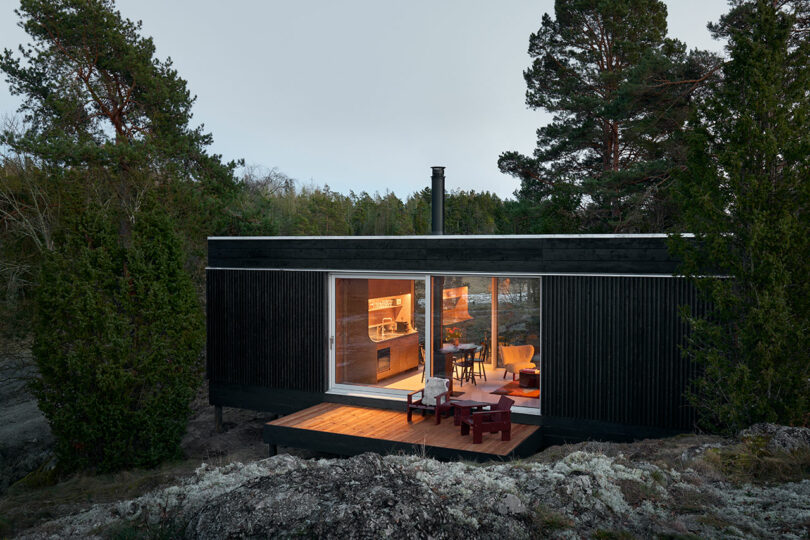
Photo: Magnus Mårdig
To learn more about Landet and commune with the Swedish countryside, visit landetstay.com.
[ad_2]
Source link
A Modern Cabin Escape Among the Treetops
[ad_1]
Tucked away in the Hoge Veluwe National Park in the Netherlands lies a unique haven – Buitenplaats Koningsweg – for artists and visitors alike. The former barracks site has been transformed into a vibrant community where dozens of creatives live and work. Now, as part of an innovative project by the municipality of Arnhem, a series of 11 “follies” have emerged within the woods, offering an opportunity for guests to immerse themselves in the forest. One of said follies is the Buitenverblijf Nest, an elevated cabin that blends in with its natural surroundings. Designed by NAMO Architecture and i29 Architects, the Nest is an unforgettable escape for anyone seeking tranquility while still having the creature comforts of home.
Nest is a holiday home that resembles a modern birdhouse, perched high alongside the treetops. Its sleek design, marked by a three-story tiny house atop a slim black base, is built with sustainability in mind. Constructed with high-quality materials that have minimal, if any, impact on the environment, the cabin is outfitted with all-electric installations, a highly insulated envelope, and solar panels on its sloped roof.
Nesting boxes on the exterior, which look like perches on a birdhouse, are built so that nuthatches, woodpeckers, and bats have a place to shelter. The black steel frame under the house also provides protection for nests and local animals.
A front deck allows guests to enjoy a meal or a cup of coffee while taking in the surrounding landscape. A floor-to ceiling sliding glass door opens up the compact main floor to expand out to the terrace.
Oversized round windows frame views of the trees and wildlife while allowing natural light to keep the interior feeling open and airy.
Approximately eight meters off the ground, the first level houses the open kitchen and living room with adjacent terrace.
Wooden stairs lead to the middle level with the bathroom, which also features round windows so nature can be enjoyed while getting ready for the day.
Another staircase leads to the bedroom, which sleeps four people side-by-side. The sloped wood roof creates a cozy spot to retire to at the end of the day to really make you feel like you’re one with the birds and the trees.
If you’re looking to escape to nature but still want to be comfortable, the Buitenverblijf Nest elevated modern cabin can be yours for approximately US $179 per night. More info here.
Photography by Jeroen Musch.
[ad_2]
Source link
Alda Ly Revels in Reeded Glass, Icelandic Baths + More
[ad_1]
Alda Ly founded ALA Studio (formerly Alda Ly Architecture) in 2017, inspired to sit at the helm of her own practice after taking a leap of faith when The Wing – a then groundbreaking co-working platform – tapped her to design their East Coast and California locations. This project marked the start of the studio’s continued work with entrepreneurs and startups, as well as established organizations looking to rethink traditional retail, healthcare, office, and cultural spaces.
Ly’s story originates in New Zealand, where she was born before moving and being raised in a working-class suburb of Los Angeles, California. Watching her cabinetmaker father draw up plans and traveling with him to visit open houses, she became interested in how others shape their spaces. Ly attended UC Berkley as an undergrad before going on to earn a Master’s degree from Harvard University’s Graduate School of Design – but she was hooked on architecture from the moment she started studying freehand drawing. In 2008, while still a student at Harvard, she helped launch MASS Design Group, the award-winning nonprofit design practice dedicated to humanitarian and socially sustainable work.
Living in New York City since 2002, Ly has long nurtured a curiosity in the evolution of work and cultural spaces, as well as in leading project teams guided by empathy. This organically led to her co-founding the Designers Assembly, an organization supporting young architects who aspire to ethically and creatively exercise entrepreneurship. It’s clear how much Ly is committed to donating her time to those who also contribute acts of service within the architecture community.
ALA Studio’s projects have a wide range, but they all share the commonalities of minimal, playful design while seamlessly combining comfort, wellness, smart planning, and fresh interior concepts. The studio often gives form to services and business models that have few spatial precedents. To arrive at each unique project solution, ALA Studio begins with a discovery phase in which an organization’s founders, team members, and users share their experiences with that brand. The studio’s ethnographic research then becomes the basis for deciding upon programming, functionality, concepts, layouts, and finishes. Ly and her team take great pride in their collective abilities to listen and collaborate in a hands-on way with clients, helping them reach the ultimate goal of meeting every commission’s potential within set time constraints and budget.
The architecture and interior design studio is a noted thought leader in biophilic design and has been featured internationally. ALA’s long list of clients includes Bloomberg, Rent the Runway, Red Bull, Christian Louboutin, and the women’s healthcare platform Tia. ALA Studio is also a certified Minority and Woman-owned Business Enterprise (M/WBE) in New York City.
We’re happy to have Alda Ly join us for this week’s Friday Five!
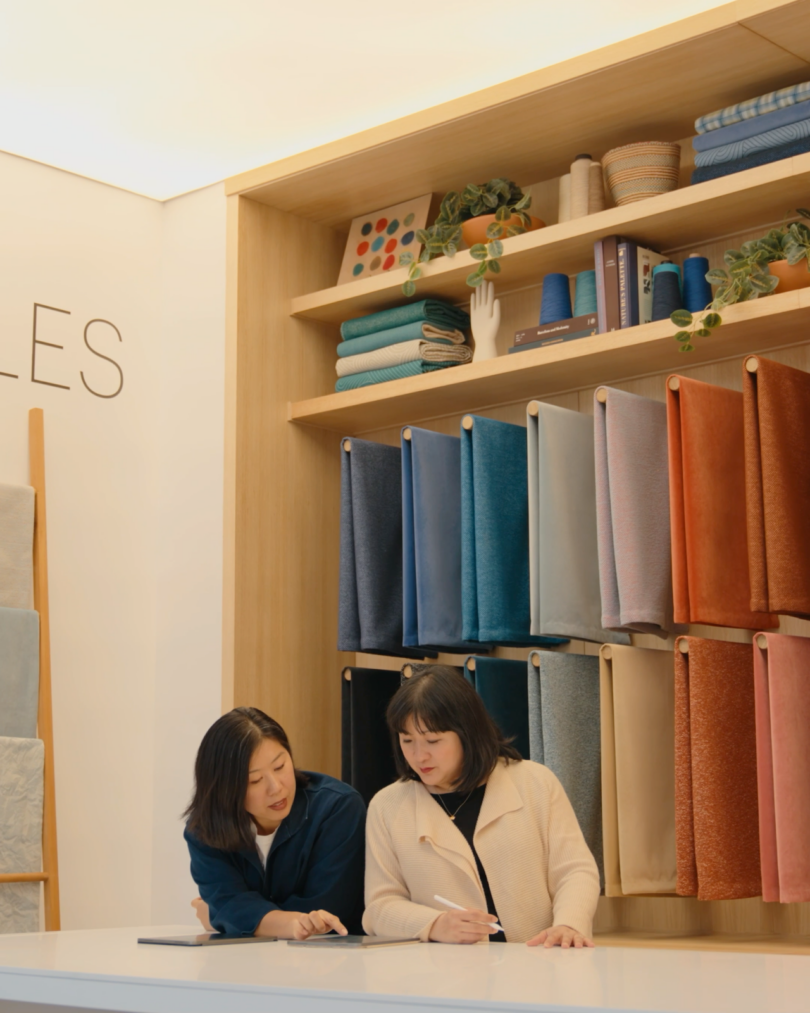
Photo: Courtesy of HBF
1. Sketching on the iPad
Drawing with pencil on paper or trace was my first love as I got into architecture. These days, I still love sketching, and with an iPad, it’s more convenient given the pace and modes of our fast-paced and frequently remote work. With a paper-like film and an app that lets me layer on drawings, sketch fit plans, or trace over an existing room view, it feels effortless and fun – and it makes me feel like I’m back in my undergraduate studio days. Sharing and presenting also become a snap, so iPads are a standard issue for all ALA team members.
2. Icelandic Baths
While working on a restaurant project in Reykjavik, I had the chance to explore Iceland’s seemingly limitless supply of hot springs and geothermal pools. Bathing in the outdoors is a relaxing, blissful way to connect with the land and find inspiration. The natural beauty here is almost overwhelming.
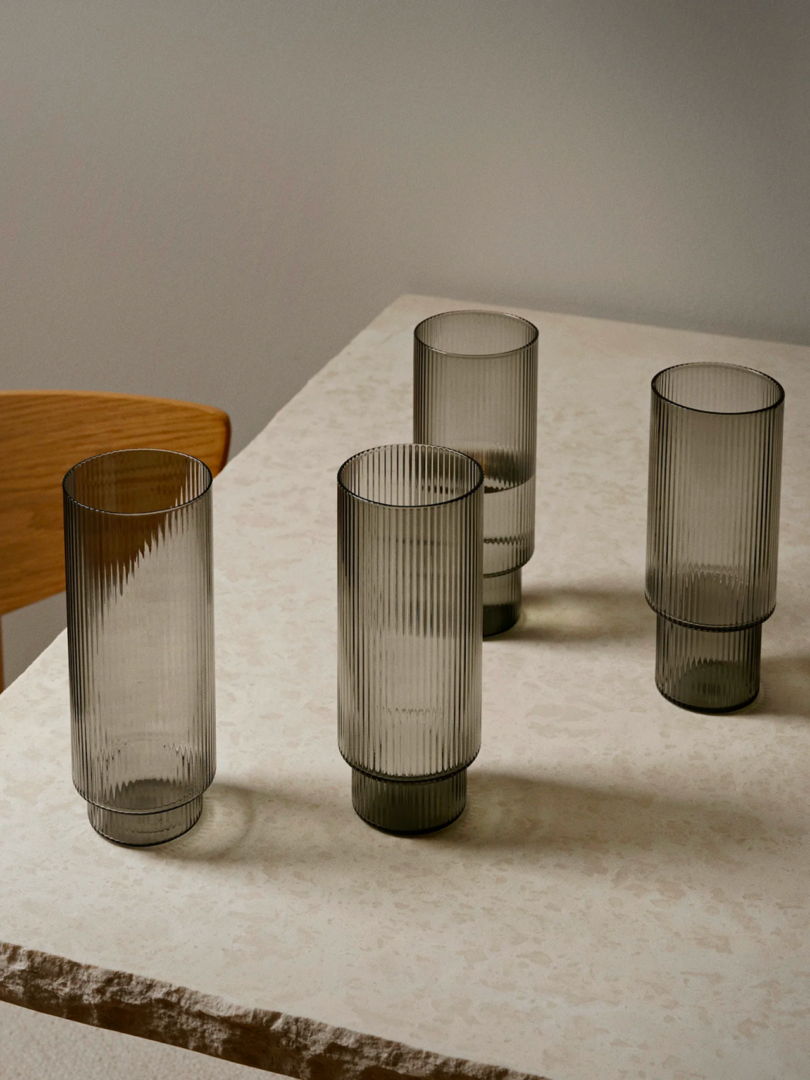
Photo: Courtesy of Ferm Living
3. Reeded Glass
I’m an unapologetic aficionado of reeded glass for all sorts of applications. I love running my fingers over the ridges. I love the mystery of the shapes on the other side. I love the different scales of ribbing that it can come in. It’s our studio’s go-to when we want to create privacy in a room while still bringing in light. The texture of real reeded glass is my favorite, but we’re never too proud to spec a ribbed film for our projects with tighter budgets. It works equally well in residential settings – even housewares and housewarming gifts! Did I mention I love reeded glass?
We’ve been lucky to work with TALEA Beer, New York’s only women-owned brewery. I’m usually a cocktail gal, and this is the only beer I truly enjoy. I love how they’ve recast beer as something that can be feminine and fun. It’s beer without frat-bro vibes, and it tastes amazing. With flavors like ‘Blackberry Mango Crush,’ they’ve really managed to stand out from the crowd. Their can designs, by the agency I Want Design, are just stunning.
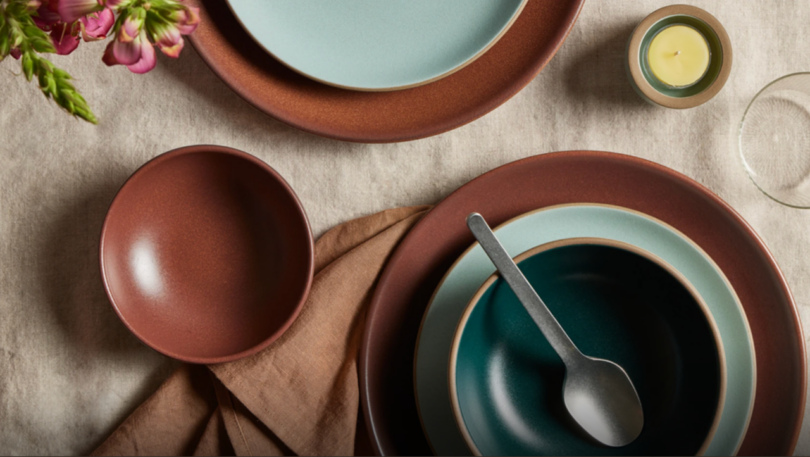
Photo: Courtesy of Heath Ceramics
5. Stoneware
That’s all we use. They’re heavy, solid, substantial, and nice to hold. I like my coffee in large, low mugs (in which my husband practices his latte art for me!). We received a set of Heath plates and bowls as a wedding gift from one of my early clients. We reluctantly trust our 3- and 5-year-olds to set the table with them, even though they’re way too heavy for their little hands, which makes setting the table exciting every time.
Work by Alda Ly + ALA Studio:
ALA Studio reimagined the flagship location of Juno Vet, a veterinary practice in Toronto, Canada, creating a better clinic experience focused on care for pets, pet parents, and staff alike. The design concept elevates the vet clinic experience by prioritizing inclusion through the lenses of function, flow, form, and materiality, sending the message that humans and animals are equally considered.
Informed by ALA’s ethos of inspired design-thinking and close attention to user experience, the Bao collection is designed for maximum comfort and usability. The first furniture collaboration between the API women-owned firm and HBF with a charming play on the Chinese word “bao” – a homonym for bun, bag, precious, and baby – this collection was conceived to bridge the gap between formal and informal, sedate and lively.
Athena Club’s new 2,300-square-foot Manhattan headquarters was designed by ALA Studio, which partnered closely with the self-care brand to translate their brand identity from paper to a welcoming space for working. Before approaching ALA Studio to fit out a new office space in Manhattan’s Flatiron District neighborhood, the Athena Club team had meticulously developed its own strong visual identity, which the studio used as inspiration to carefully curate mood boards and craft a custom approach to bring the visuals to life.
ALA Studio is also behind the third “taproom” for TALEA, the first female and veteran-owned production brewery in New York City. A cafe by day and a bar by night, TALEA’s West Village taproom is its first in Manhattan, with two locations already up and running in Brooklyn. The concept for this location is inspired by the history of the neighborhood and TALEA’s unique founding story of two women breaking ground in the overwhelmingly traditionally male-dominated industry of brewing. As such, the new taproom on Christopher Street reclaims the masculine identity of a West Village saloon to celebrate the voices of women and LGBTQ+ communities in the Village, all while serving Talea’s popular sour brews in an elevated, vibrant space.
[ad_2]
Source link

